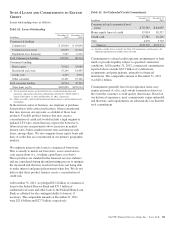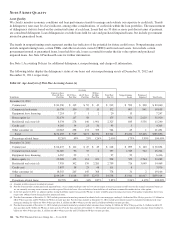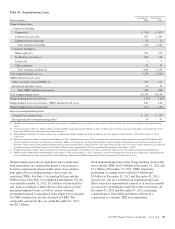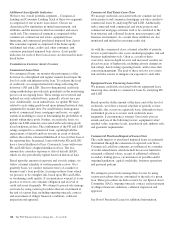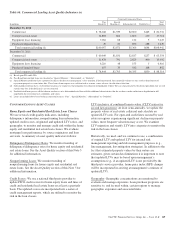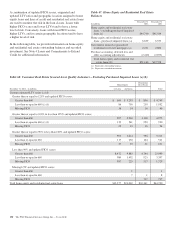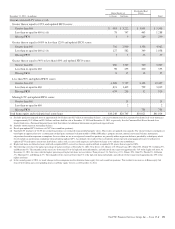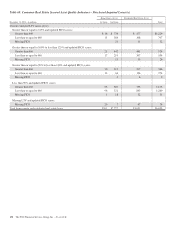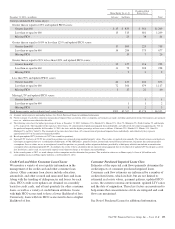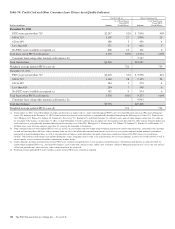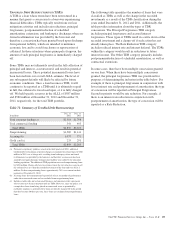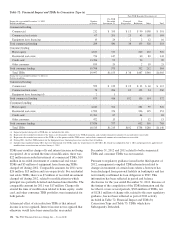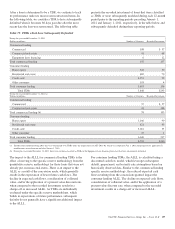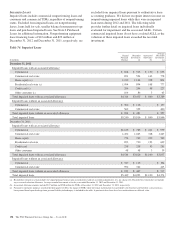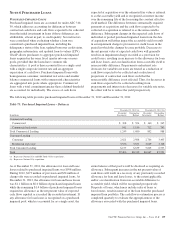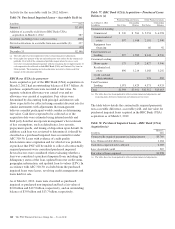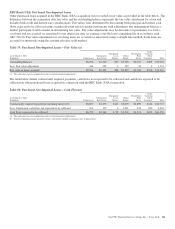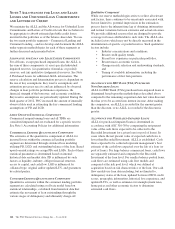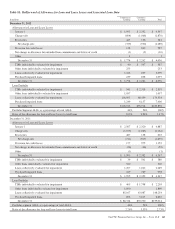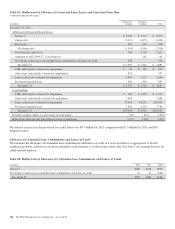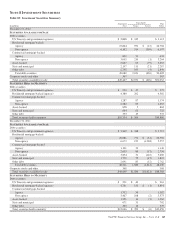PNC Bank 2012 Annual Report Download - page 174
Download and view the complete annual report
Please find page 174 of the 2012 PNC Bank annual report below. You can navigate through the pages in the report by either clicking on the pages listed below, or by using the keyword search tool below to find specific information within the annual report.
T
ROUBLED
D
EBT
R
ESTRUCTURINGS
(TDR
S
)
A TDR is a loan whose terms have been restructured in a
manner that grants a concession to a borrower experiencing
financial difficulties. TDRs typically result from our loss
mitigation activities and include rate reductions, principal
forgiveness, postponement/reduction of scheduled
amortization, extensions, and bankruptcy discharges where no
formal reaffirmation was provided by the borrower and
therefore a concession has been granted based upon discharge
from personal liability, which are intended to minimize
economic loss and to avoid foreclosure or repossession of
collateral. In those situations where principal is forgiven, the
amount of such principal forgiveness is immediately charged
off.
Some TDRs may not ultimately result in the full collection of
principal and interest, as restructured, and result in potential
incremental losses. These potential incremental losses have
been factored into our overall ALLL estimate. The level of
any subsequent defaults will likely be affected by future
economic conditions. Once a loan becomes a TDR, it will
continue to be reported as a TDR until it is ultimately repaid
in full, the collateral is foreclosed upon, or it is fully charged
off. We held specific reserves in the ALLL of $587 million
and $580 million at December 31, 2012 and December 31,
2011, respectively, for the total TDR portfolio.
Table 71: Summary of Troubled Debt Restructurings
In millions
Dec. 31
2012
Dec. 31
2011
Total consumer lending (a) $2,318 $1,798
Total commercial lending 541 405
Total TDRs $2,859 $2,203
Nonperforming $1,589 $1,141
Accruing (b) 1,037 771
Credit card (c) 233 291
Total TDRs $2,859 $2,203
(a) Pursuant to regulatory guidance issued in the third quarter of 2012, additional
troubled debt restructurings related to changes in treatment of certain loans of $366
million in 2012, net of charge-offs, resulting from bankruptcy where no formal
reaffirmation was provided by the borrower and therefore a concession has been
granted based upon discharge from personal liability were added to the consumer
lending population. The additional TDR population increased nonperforming loans
by $288 million. Charge-offs have been taken where the fair value less costs to sell
the collateral was less than the recorded investment of the loan and were $128.1
million. Of these nonperforming loans, approximately 78% were current on their
payments at December 31, 2012.
(b) Accruing loans have demonstrated a period of at least six months of performance
under the restructured terms and are excluded from nonperforming loans.
(c) Includes credit cards and certain small business and consumer credit agreements
whose terms have been restructured and are TDRs. However, since our policy is to
exempt these loans from being placed on nonaccrual status as permitted by
regulatory guidance as generally these loans are directly charged off in the period
that they become 180 days past due, these loans are excluded from nonperforming
loans.
The following table quantifies the number of loans that were
classified as TDRs as well as the change in the recorded
investments as a result of the TDR classification during the
years ended December 31, 2012 and 2011. Additionally, the
table provides information about the types of TDR
concessions. The Principal Forgiveness TDR category
includes principal forgiveness and accrued interest
forgiveness. These types of TDRs result in a write down of the
recorded investment and a charge-off if such action has not
already taken place. The Rate Reduction TDR category
includes reduced interest rate and interest deferral. The TDRs
within this category would result in reductions to future
interest income. The Other TDR category primarily includes
postponement/reduction of scheduled amortization, as well as
contractual extensions.
In some cases, there have been multiple concessions granted
on one loan. When there have been multiple concessions
granted, the principal forgiveness TDR was prioritized for
purposes of determining the inclusion in the table below. For
example, if there is principal forgiveness in conjunction with
lower interest rate and postponement of amortization, the type
of concession will be reported as Principal Forgiveness.
Second in priority would be rate reduction. For example, if
there is an interest rate reduction in conjunction with
postponement of amortization, the type of concession will be
reported as a Rate Reduction.
The PNC Financial Services Group, Inc. – Form 10-K 155


